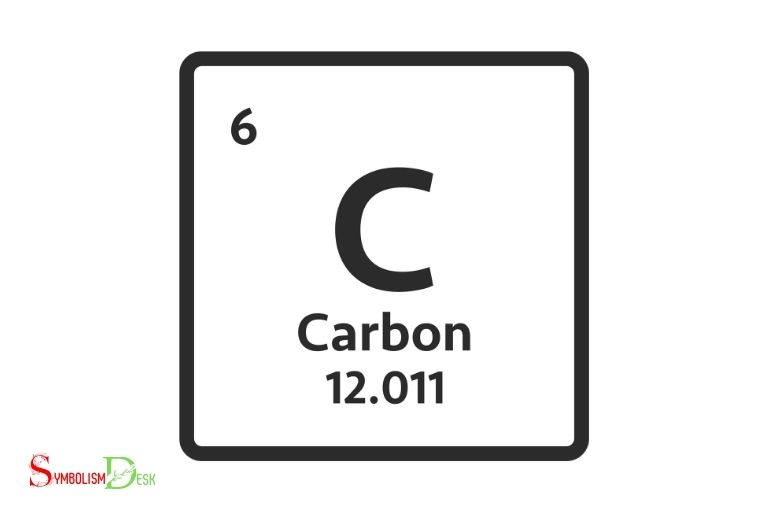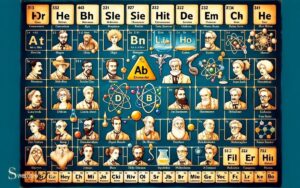What is the Meaning of Chemical Symbol? Chemical element!
The meaning of a chemical symbol is a notation consisting of one or two letters that represent a particular chemical element in the periodic table.
Chemical symbols are abbreviations used in chemistry to conveniently represent elements without having to write their full names.
They are derived from the element’s name, either in English or Latin. For example, the chemical symbol for hydrogen is ‘H’, while for sodium, it is ‘Na’ (derived from the Latin name ‘natrium’).
Using chemical symbols allows chemists and scientists to easily and concisely represent elements in chemical formulas, equations, and reactions.
This simplifies communication and understanding in the field of chemistry. For instance, instead of writing out “hydrogen” and “oxygen” in the chemical formula for water, we can simply use their chemical symbols, ‘H’ and ‘O’, and write ‘H2O’.
Understanding the Meaning of Chemical Symbols
| Chemical Symbol | Element Name | Meaning of Chemical Symbol |
|---|---|---|
| H | Hydrogen | Named after Greek words “hydro” (water) and “genes” (forming) because it forms water when combined with oxygen |
| He | Helium | Named after the Greek god of the sun, Helios, due to its identification in the sun’s spectrum |
| Li | Lithium | Derived from the Greek word “lithos” meaning stone because it was first discovered in a mineral source |
| Be | Beryllium | Named after the mineral beryl, in which it was first discovered |
| B | Boron | Named after the mineral borax, in which it was first isolated |
| C | Carbon | Derived from the Latin word “carbo” meaning charcoal, a common form of carbon |
| N | Nitrogen | Named after the Greek words “nitron” (native soda) and “genes” (forming) because it forms nitrates |
| O | Oxygen | Named after the Greek words “oxy” (sharp) and “genes” (forming) because it was thought to form all acids |
| F | Fluorine | Named after the Latin word “fluere” meaning to flow, due to its presence in the mineral fluorspar |
| Ne | Neon | Derived from the Greek word “neos” meaning new, because it was a newly discovered element |
| Na | Sodium | Named after the English word “soda” because it forms salts like sodium carbonate |
| Mg | Magnesium | Named after the Greek region of Magnesia, where magnesium-rich minerals were found |
| Al | Aluminum | Derived from the Latin word “alumen” meaning alum, a compound it forms in nature |
| Si | Silicon | Named after the Latin word “silex” meaning flint, a common form of silicon dioxide |
| P | Phosphorus | Named after the Greek words “phos” (light) and “phoros” (bringing) because it glows in the dark |
| S | Sulfur | Derived from the Latin word “sulphur” meaning brimstone |
| Cl | Chlorine | Named after the Greek word “chloros” meaning pale green, due to its color |
| Ar | Argon | Derived from the Greek word “argos” meaning inert, because it does not react chemically |
| K | Potassium | Derived from the English word “potash” because it forms salts like potassium carbonate |
| Ca | Calcium | Named after the Latin word “calx” meaning lime, as it forms calcium oxide (quicklime) |
Key Takeaway

Five Facts About: Chemical Symbols
Understanding The Basics: What Is A Chemical Symbol?
Chemical symbols are an essential part of chemistry and science. They represent elements and allow scientists to communicate about chemical substances precisely.
Understanding the basics of a chemical symbol is the primary step in learning about chemistry.
In this section of the blog post, we will discuss the definition of a chemical symbol, trace their origins and development, and explore the significance of chemical symbols in chemistry and science.
Definition Of Chemical Symbol
A chemical symbol is a shorthand notation representing elements in the periodic table. They are typically one or two letters long and can be either uppercase or lowercase. A chemical symbol is a useful tool for quickly identifying and referencing specific elements in chemical formulas and equations. For example, the symbol “H” represents the element hydrogen, while “O” represents oxygen. In some cases, elements with names that have more than one letter use a derivative symbol explained by the inclusion of the first letter capitalized and the second letter in lowercase, such as “Ca” for calcium and “Na” for sodium. This system of notation helps to streamline communication and understanding in the field of chemistry.
For example, the chemical symbol for oxygen is o, and the symbol for potassium is k.
Origins And Development Of Chemical Symbols
Chemical symbols were first introduced in the early 19th century when john dalton created the atomic theory.
Dalton used circles with letters inside them to represent atoms of different elements. In 1814, jöns jakob berzelius developed a more standardized notation system using one or two letters to represent the elements.
The modern periodic table, which is based on chemical symbols, was developed by dmitri mendeleev in 1869.
Over time, as more elements were discovered, chemical symbols were added to the periodic table, expanding its scope and usefulness.
The Significance Of Chemical Symbols In Chemistry And Science
Chemical symbols are essential tools for scientists in chemistry and other scientific fields.
Some of their significance are:
- They allow scientists to communicate about elements and compounds accurately and succinctly.
- They allow scientists to predict the properties of elements and compounds based on their location in the periodic table.
- They form the basis for naming chemical compounds and writing chemical equations.
- They help in identifying the products of chemical reactions and their quantities.
Chemical symbols are vital in the field of chemistry and science, allowing scientists to communicate and make predictions about elements and compounds.
By understanding the basics of chemical symbols and their significance, we can appreciate their importance and usefulness in various scientific fields.
Structure Of Chemical Symbols: How They Function And Convey Information
Elements Of Chemical Symbols
Chemical symbols are abbreviations used to represent elements in the periodic table in a standard way. The symbols are made up of one or two letters derived from the element’s name.
Here are some key elements of chemical symbols:
- The first letter of the symbol is always capitalized, while the second letter is always lowercase. For instance, the symbol for oxygen is ‘o,’ while the symbol for chlorine is ‘cl.’
- Some symbols are derived from latin names, for instance, au is the symbol for gold, derived from the latin term “aurum” that means shining dawn. The same is true for silver (ag), lead (pb), and many others.
- In some cases, elements have the same initials. In such instances, the symbols are formed from the first letter of the latin or greek name of the element. For example, iron is ‘fe’ in latin “ferrum,” and fluorine is ‘f’ derived from “fluor” of greek origin.
- The symbols can also be used to represent isotopes, meaning the same element with a different number of neutrons. In this case, the mass number is written after the symbol as a superscript. For instance, the symbol for carbon-14 (an isotope of carbon) is ’14c.’
Examples Of Chemical Symbols And Their Meanings
Chemical symbols convey much information in a concise form.
Here are some examples of chemical symbols and their meanings:
- H: Hydrogen, a tasteless and odorless gas that is the most abundant element in the universe. Hydrogen gas is used for many applications such as in fuel cells and welding.
- C: Carbon, a non-metallic chemical element that is extensively used in manufacturing and construction. It is the basis of organic chemistry and is found in numerous compounds, including diamond and graphite.
- Fe: Iron, a metal with many uses, including in construction, manufacturing of steel, and medical purposes. It is also an essential element for several biological processes.
- Na: Sodium, an alkali metal that is highly reactive and is used in a range of applications, such as in the manufacturing of soap and glass.
Chemical Formulae And Equations: How Symbols Are Used In Formulating Compounds
Chemical symbols and their combinations form chemical formulae. A chemical formula indicates the types of atoms present in a molecule, and the proportions they are combined in.
Here’s how chemical symbols are used:
- Each element gets a chemical symbol as discussed earlier. For instance, sodium (na) and chlorine (cl) combine to form nacl, also known as table salt.
- Chemical formulae are used to write out chemical equations that represent chemical reactions that occur when two or more compounds are combined. Chemical equations help scientists and researchers understand a range of processes, from basic decomposition to complex biological transformations.
Chemical symbols and formulas are an integral part of chemistry and the sciences.
They have a range of uses, from representing and identifying elements and isotopes, to writing out chemical equations for use in solving many scientific problems.
The Importance Of Chemical Symbols: How They Facilitate Learning And Research In Chemistry
Chemical symbols are a shorthand way of representing chemical elements and compounds, which are essential to the field of chemistry.
They are used extensively in chemistry education and research, science communication and publication, and scientific progress.
In this blog post, we will explore the importance of chemical symbols and how they facilitate learning and research in chemistry.
The Role Of Chemical Symbols In Chemistry Education
Chemical symbols play a crucial role in chemistry education.
Here are some key points:
- Chemical symbols provide a simple and standardized way of representing chemical elements and compounds, allowing students to easily identify and differentiate between them.
- The use of chemical symbols helps to simplify the communication of complex chemical concepts and facilitates the understanding and retention of information.
- By learning how to read and write chemical symbols, students develop essential skills and knowledge that are transferrable to other areas of science and engineering.
Applications Of Chemical Symbols In Science Communication And Publication
Chemical symbols are also extensively used in science communication and publication.
Here are some key points:
- When communicating scientific findings, chemical symbols provide a standardized language that enables clear and concise communication between scientists, regardless of their native language.
- The use of chemical symbols in scientific publications ensures that the information is both accurate and clear, allowing other researchers to replicate and build upon the study.
- The use of standardized chemical symbols has become a requirement in many scientific publications, ensuring uniformity and aiding in the dissemination and understanding of scientific research.
The Advantages Of Standardized Chemical Symbols For Scientific Progress
Standardized chemical symbols have a number of advantages that greatly aid scientific progress.
Here are some key points:
- Standardized chemical symbols provide a common language that is used across the globe, enabling scientists to communicate and collaborate more effectively.
- The use of standardized chemical symbols eliminates the need for lengthy written explanations, saving valuable time and resources.
- Standardized chemical symbols enable scientists to quickly search and organize large amounts of chemical data, allowing for more efficient analysis and discovery.
Chemical symbols play a crucial role in chemistry education, science communication and publication, and scientific progress.
By simplifying the communication of complex chemical concepts and providing a standardized language, chemical symbols continue to facilitate learning and research in chemistry today.
Advanced Topics In Chemical Symbols: Isotopes, Radioactivity, And Beyond
Chemical symbols are essential for scientists involved in researching, analyzing, and promoting chemical advancements.
These symbols are a shorthand way of representing the names of the chemical elements, with each symbol comprising one or two letters.
The chemical symbol helps to simplify the complex processes and facilitate the communication between scientists.
Advanced topics in chemical symbols include isotopes, radioactivity, and beyond.
Isotopes And Their Symbols
Isotopes are atoms of the same element that have a different number of neutrons. This means that despite the same number of protons, isotopes may have different mass numbers.
The symbol for an isotope includes the atomic number and the mass number.
- The atomic number is the number of protons in the nucleus of an atom and is represented by the symbol ‘z.’
- The mass number is the sum of protons and neutrons and is represented by the symbol ‘a.’
Therefore, the symbol for an isotope is written in the following way:
“
X-Za
“
Where x is the chemical symbol for the element, z is the atomic number, and a is the mass number.
Radioactivity And Nuclear Symbols
Radioactivity refers to the spontaneous decay of an unstable atomic nucleus. The nuclear symbol is used to represent a specific isotope that is radioactive.
Nuclear symbols contain three types of subscripts:
- Mass number (a): Represented by the upper left subscript
- Atomic number (z): Represented by the lower left subscript
- Atomic symbol: Represented by the symbol in the middle
For example, the symbol for carbon-14, a radioactive isotope, is written as:
“
^14_6C
“
Where 14 is the mass number, 6 is the atomic number, and c is the chemical symbol for carbon.
Recent Developments And Future Directions For Chemical Symbol Usage
The use of chemical symbols is an essential tool for scientists, but with technological advancements, their use has expanded.
One innovation has been using chemical symbols for molecular compounds and complex chemical reactions. The use of chemical symbols is also vital for teaching chemistry in schools and universities.
Recent developments in artificial intelligence have implications on the industrial use of chemical symbols.
Although chemical nomenclature is well established, automation and machine learning algorithms can accelerate the identification of chemical compounds.
This development will impact the pharmaceutical industry, where the discovery of new molecules is critical.
Consequently, chemical symbols will continue to have practical applications in the field of chemical research.
The use of chemical symbols is vital for the understanding and communication of complex chemical processes in research and education.
The use of isotopes and radioactivity in chemical symbols provides critical information to scientists in their endeavors.
With the advent of advanced machine learning and automation in chemistry, chemical symbols will continue to develop into more sophisticated forms.
Is There a Symbol for Love in Chemistry?
Chemistry doesn’t have a specific symbol for love, but it does explore the synergy between elements. However, the meaning of black love symbol is subjective and can be interpreted differently by individuals. In chemistry, compounds and reactions come together to create powerful connections, much like the deep bond symbolized by black love.
FAQ About What Is The Meaning Of Chemical Symbol
What Is A Chemical Symbol And What Does It Represent?
A chemical symbol is a shorthand way of representing an element. It can provide information about the element, like its name and atomic number.
Who Invented Chemical Symbols?
Swedish chemist jöns jakob berzelius is credited with inventing the modern system of chemical symbols, including the use of letters to represent elements.
What’s The Difference Between A Chemical Symbol And A Chemical Formula?
A chemical symbol represents a single element, while a chemical formula represents a molecule composed of two or more elements.
Why Are Some Chemical Symbols Derived From Latin Names?
Latin was the language of science and scholarship during the middle ages and renaissance, so many elements discovered during this time were named using latin roots.
Can Two Elements Have The Same Chemical Symbol?
No two elements can have the same chemical symbol. Each element is represented by a unique combination of one or two letters.
Conclusion
A chemical symbol is a shorthand notation used to represent a particular chemical element.
It consists of one or two letters, often derived from the element’s name, that are universally recognized by chemists worldwide.
The creation of chemical symbols allowed scientists to communicate complex chemical formulas quickly and accurately, facilitating the development of the periodic table and modern chemistry as we know it today.
Understanding chemical symbols is essential for anyone studying chemistry, as they form the foundation of the subject.
Furthermore, chemical symbols are still used extensively in many sectors, including science, medicine, and industry, where their concise and standardized form is vital for communication.
Thus, it is important for students and professionals alike to grasp the meaning and significance of chemical symbols to effectively participate in chemical discourse and advance scientific knowledge.






